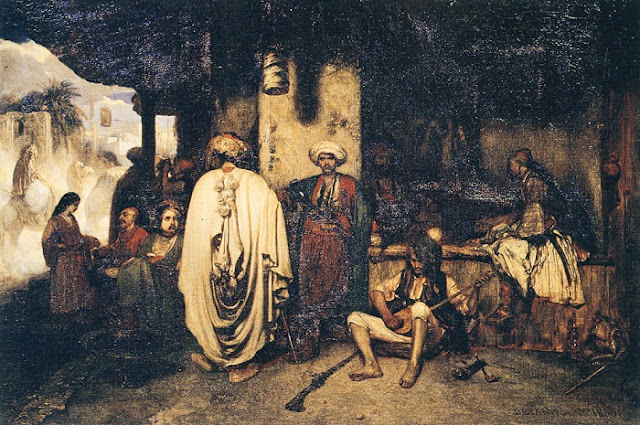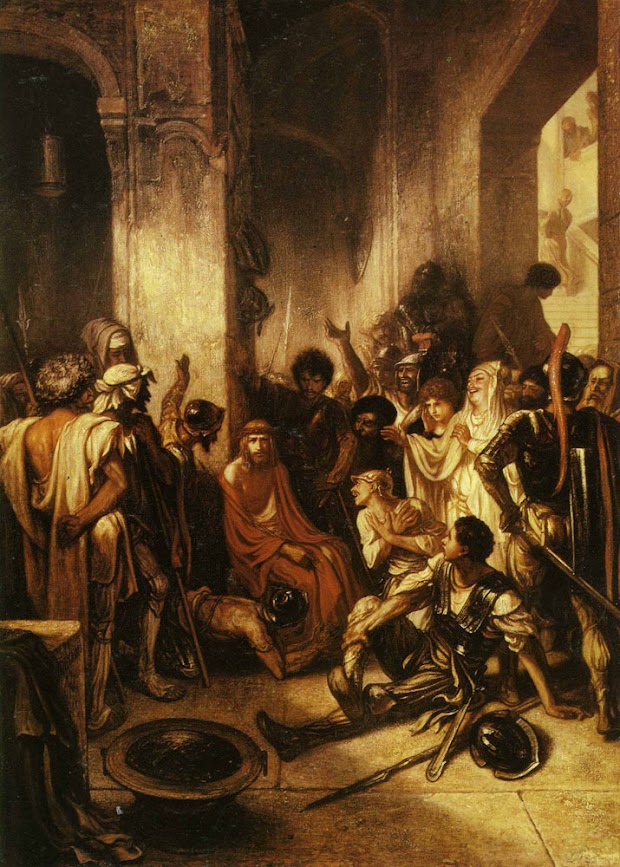Alexandre-Gabriel Decamps
Warrior with bow and arrow
Oil on canvas
31 x 51 cm
Private collection
Alexandre-Gabriel Decamps (March 3, 1803 – August 22, 1860) was a French painter noted for his Orientalist works.
Alexandre-Gabriel Decamps (1803-1860)
Le Campement de bohémiens/ The Bohemian Encampment
Oil on wood
18 x 24.8 cm
Alexandre Gabriel Decamps (French, 1803–1860)
Interior with mother and children
Oil on panel
42.3 x 35.5 cm. (16.7 x 14 in.)
Private collection
Alexandre-Gabriel Decamps
The Beggars
Oil on canvas
17.00 x 27.40 cm
Scottish National Gallery, Edinburgh, UK
Decamps specialised in scenes of the Muslim East, which is the probable setting for this picture. He painted the subject of beggars on several occasions. Here, three beggar women sit and gossip, sheltering from the heat of the day. A fourth sits in a shady doorway, holding her baby on her knee. Splashes of sunlight strike the lime-washed walls on either side of the door. Although it is a Romanticised image, the picture could be read in the context of social conditions in France in the late 1840s. Starvation among the peasantry was common, aggravated by the great famine of 1846-7 and the political upheaval of the 1848 Revolution. Intentionally or not, Decamps has given the beggar women in the painting red, white and blue scarfs, recalling the colours of the tricolour flag. More on this painting

Alexandre-Gabriel Decamps (1803–1860)
Albanian dancers, circa 1835
Oil on canvas
Height: 77 cm (30.3 in); Width: 124 cm (48.8 in)
Musée des Beaux-Arts de Brest, France
Generally characterized by its thickness, the painter's touch here is finer and faster, suggesting that it is a sketch. Occupying the center of the painting, two moving dancers face each other in a sort of confrontation. They are surrounded by several characters: on the left, there are musicians, one of whom blows a " zuma " (a kind of conical oboe), while the other plays a plucked string instrument. The scene is inscribed in a natural landscape: it stands out against a twilight sky which contrasts, in the lower part, with the intensity of the blue of the sea. More on this painting
Alexandre-Gabriel Decamps, French, 1803–1860
Cypriot Woman Smoking a Chibouk, after 1828
Watercolor, gouache, and touches of pen and black and brown ink on paper
5 13/16 × 4 3/16 in, 14.8 × 10.6 cm
Clark Art Institute, Williamstown
Decamps was born in Paris. In his youth he travelled in the East, and reproduced Oriental life and scenery with a bold fidelity to nature that puzzled conventional critics. His powers, however, soon came to be recognized, and he was ranked along with Delacroix and Ingres as one of the leaders of the French school. At the Paris Exhibition of 1855 he received the grand or council medal.
Alexandre-Gabriel Decamps (1803–1860)
The Defeat of the Cimbri, c. 1833
Oil on canvas
Height: 130 cm (51.1 in); Width: 195 cm (76.7 in)
Louvre Museum
The Cimbrian or Cimbric War (113–101 BC) was fought between the Roman Republic and the Germanic and Celtic tribes of the Cimbri and the Teutons, Ambrones and Tigurini, who migrated from the Jutland peninsula into Roman controlled territory, and clashed with Rome and her allies. The Cimbrian War was the first time since the Second Punic War that Italia and Rome itself had been seriously threatened. More on The Cimbrian War
Alexandre-Gabriel Decamps
Turkish guardhouse on the Smyrna-Magnesia road, c.1833
91 x 155 cm
Oil on canvas
Musée Condé, Chantilly
In 1402, Tamerlane stormed Smyrna and massacred almost all the inhabitants. The Mongol conquest was only temporary, but Smyrna was recovered by the Turks under the Aydın dynasty after which it became Ottoman, when the Ottomans took over the lands of Aydın after 1425. More on Smyrna
Alexandre-Gabriel Decamps (French, Paris 1803–1860 Fontainebleau)
The Turkish Patrol
Oil on canvas
29 1/4 x 36 3/8 in. (74.3 x 92.4 cm)
The Metropolitan Museum of Art
The present picture depicts Turkish military patrols making their rounds at Smyrna—now Izmir—which Decamps visited in 1828. It is a late variant of his first major Orientalist subject, exhibited at the Paris Salon of 1831 (now in the Wallace Collection, London). Decamps belonged to the first generation of French painters to popularize scenes of everyday life set in the Middle East. More on this painting
Alexandre-Gabriel Decamps, 1803 - 1860
BATTLE BETWEEN A GREEK AND A TURK
Pastel on paper
22.5 by 31.5cm., 9 by 12½in.
Private collection
The Greco-Turkish War of 1897 was a war fought between the Kingdom of Greece and the Ottoman Empire. Its immediate cause was the question over the status of the Ottoman province of Crete, whose Greek majority had long desired union with Greece. Despite the Ottoman victory on the field, an autonomous Cretan State under Ottoman suzerainty was established the following year. More on The Greco-Turkish War
Attributed to Alexandre-Gabriel Decamps
Looting Saracen
Oil on canvas
46.5 x 38 cm.
Private collection
Decamps was the founding father of Orientalism since he revealed everyday Oriental life in the 1831 Salon in Paris. His subjects and style with strong contrast of light and thick material became the reference for painters but also photographers and writers. He was the most influential painter on Orientalism and was proclaimed the chief of the new Orientalist School. Delacroix referred to him in the Women of Algiers (1834), and the Fanatics of Tangiers (1838).
Alexandre-Gabriel Decamps (1803–1860)
The Punishment of the Hooks
90 x 135.5 cm
Oil on canvas
Wallace Collection, London
Exhibited at the Paris Salon of 1839, this became one of Decamps’s most renowned and admired paintings. Bound prisoners, probably thieves, are being thrown over battlements on to massive hooks. It is not known whether Decamps witnessed such a scene during his Oriental tour in 1828. More on this painting
Théophile Gautier's Constantinople (1853) was described as an “immense verbal Decamps” by Henry James. Maxime Du Camp named him the Christopher Columbus of the Orient and Théophile Gautier compared his role as the discoverer of the Orient to the role of Jean-Jacques Rousseau as the discoverer of nature in the eighteenth century. Christine Peltre concludes that the only equivalent to his fame were the Arabian Nights (One Thousand and One Nights).
Alexandre Gabriel Decamps (Paris, France, 1803 - 1860)
The Watering Place, c. 1850-1860
Oil on panel
Height: 20.1 cm, Width: 30.2 cm
Aberdeen Art Gallery and Museums Collections
Alexandre Gabriel Decamps (Paris, France, 1803 - 1860)
The Watering Place, c.1828
Height: 16.2 cm, Width: 21 cm
Aberdeen Art Gallery and Museums Collections
Decamps' style was characteristically and intensely French. It was marked by vivid dramatic conception, bold and even rough brushstrokes, and startling contrasts of color and of light and shade. His subjects embraced an unusually wide range. He availed himself of his travels in the East in dealing with scenes from Scripture history, which he was probably the first of European painters to represent with their true and natural local background. Of this class were his Joseph sold by his Brethren (See below), Moses taken from the Nile (See below), and his scenes from the life of Samson, nine vigorous sketches in charcoal and white.
Alexandre-Gabriel Decamps (1803–1860)
Joseph Sold by his Brethren, c. 1838
Oil on canvas
H 30.5 x W 40.8 cm
The Wallace Collection
A reduced version, with minor differences, of a painting shown at the Paris Salon of 1839 (now untraced). Joseph, the favourite of his father Jacob, is sold by his jealous brothers to passing Midianite merchants who will take him to Egypt. More on this painting
Alexandre-Gabriel Decamps (1803–1860)
The Finding of Moses, c. 1837
Oil on canvas
H 29.2 x W 46.1 cm
The Wallace Collection
Exhibited at the 1839 Salon, this was Decamps’s first religious scene in oil. Pharoah’s daughter, accompanied by her attendants, discovers Moses in an ark of bulrushes on a bank of the Nile. He had been placed in the ark by his mother to escape Pharaoh’s orders to kill newborn Israelite boys. More on this painting
Alexandre-Gabriel Decamps
Christ at the Praetorium, c. 1847
Oil on canvas
144 x 104.5 cm
Musée d'Orsay, Paris
Pilate was the Roman procurator (governor) of Judaea, appointed by the emperor in Rome. He lived in Caesarea, when he was in Jerusalem he resided at Herod’s Palace, which served as the ‘praetorium’or governor’s palace after Judaea came under direct Roman rule in 6AD.
As the Jews knew that the Romans would not agree to execute a man for a Jewish religious crime such as blasphemy, the Jewish leaders claimed they had found Jesus guilty of a political crime – opposing the emperor and Roman rule. Pilate asked Jesus if he was ‘the King of the Jews’ – a title used in mockery, as the Kingdom of Judaea had been abolished when the Romans deposed Archelaus in 6AD. Pilate told the chief priests that he thought Jesus was innocent of the charges brought against him. More on this painting
Perhaps the most impressive of his historical pictures is Defeat of the Cimbri (See above), representing the conflict between a horde of barbarians and a disciplined army. Decamps produced a number of genre pictures, chiefly scenes from French and Turkish domestic life, the most marked feature of which is humour. The same characteristic attaches to many of his numerous animal paintings; Decamps was especially fond of painting monkeys. His well-known painting The Monkey Connoisseurs satirizes the jury of the French Academy of Painting, which had rejected several of his earlier works on account of their divergence from any known standard.
Attributed to Alexandre-Gabriel Decamps
French officers in a wooded narrow pass
Oil on canvas
40 x 31 cm
Private collection
Alexandre-Gabriel Decamps Paris, 1803 - Fontainebleau, 1860
Neapolitan fishermen on a background of a glowing sky
Oil on canvas
h: 41.50 w: 66.50 cm
Private collection
Our fishing boat dates from the best period of its production, that of the 1830s which saw the birth of The Battles of the Cimbri (1833). A drawing of the same subject kept at the Condé museum in Chantilly (See above) testifies to the artist's reflection in the development of his subject. With Dante de Delacroix's boat leading the way and despair tinting the sky with the Raft of the Medusa for guide, Decamps deals here with a banal episode in a tragic scene; a simple fishing becomes an execution perpetrated in gangs in a landscape whose ardor and violence announce the inevitable: death! More on this painting
Alexandre-Gabriel Decamps (1803–1860)
The Witches in Macbeth, c. 1841–1842
Oil on canvas
H 29.4 x W 40.4 cm
The Wallace Collection
The subject is taken from Shakespeare’s 'Macbeth', IV, i. Before Macbeth learns his fate, the three witches gather round their cauldron and one adds a toad to its ghastly contents. More on this painting
His paintings and drawings were first made familiar to the English public through the lithographs of Eugene le Rouit.
He died in 1860 in consequence of being thrown from a horse while hunting at Fontainebleau.
Please visit my other blogs: Art Collector, Mythology, Marine Art, Portrait of a Lady, The Orientalist, Art of the Nude and The Canals of Venice, Middle East Artists, 365 Saints and 365 Days, also visit my Boards on Pinterest
Images are copyright of their respective owners, assignees or others.
Some Images may be subject to copyright
I don't own any of these images - credit is always given when due unless
it is unknown to me. if I post your images without your permission, please tell
me.
I do not sell art, art prints, framed posters or reproductions. Ads are
shown only to compensate the hosting expenses.
If you enjoyed this post, please share with friends and family.
Thank you for visiting my blog and also for liking its posts and pages.
Please note that the content of this post primarily consists of articles
available from Wikipedia or other free sources online.






















.jpg)

No comments:
Post a Comment